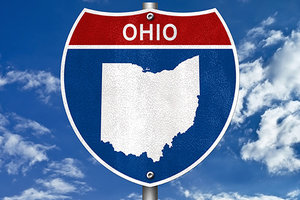The jolt of seeing a woman conscious and talking during surgery left a lasting impression in 1971 when acupuncture was on the national news. A "New York Times" reporter covering President Nixon's trip to China fell ill with appendicitis and surgeons successfully used acupuncture for anesthesia and post-operative pain.
Those two images resonated so deeply that when acupuncture became legal in 2000. My business partner, Helen Yee, and I joined a six-week AOMA school trip to China to see how acupuncture is taught there. We experienced in- and out-patient hospital internships, attended numerous lectures and formed invaluable friendships.
We became convinced that adding an acupuncture program to the American Institute of Alternative Medicine (AIAM) was not a good idea, as it's an expensive program to start and run. There were no acupuncturists in Ohio or any contiguous states, no administrative rules or board oversight. The next schools were a 7-hour drive away (in Chicago and Baltimore). Ohioans didn't know what acupuncture was and weren't utilizing it.
On the day we returned from our China trip, a man called half a dozen times and showed up at our front door. He came to work that Monday before we could even hire him. He was an AOM Professor from China who was teaching in New Mexico. AIAM's first class of acupuncture started in 2001, and had a graduating class of six. We have since graduated 165 of the 243 acupuncturists licensed in the state of Ohio.
Practiced in China for thousands of years, acupuncture is a comparatively new profession in the U.S. and in its infancy in Ohio. Many milestones have been reached to lobby for legislative changes, educate the public, and work toward integrative practice. In 2001, when the AIAM program started, acupuncture was largely unknown in the Midwest and the clinic saw at most 10 patients weekly. In the last year AIAM Interns provided 7,990 treatments and AIAM faculty provided 2,425 treatments.
In 2000 all acupuncturists needed was a physician referral to treat a patient. The referral law was changed in 2008 to require physician referral only in the first year of licensure. Acupuncture education was initially approved as a diploma program in 2000. In 2017 it was recognized as a master's degree. Ohio recognized Chinese herbal therapy and started licensing Oriental medicine in 2014.
In January 2018 Ohio became the first state in the Midwest to offer Medicaid coverage for acupuncture provided by non-physician acupuncturists for the treatment of migraines or low back pain. Ohio Medicaid will cover up to 30 acupuncture treatments per year for these conditions. According to Jared West, president of the Ohio Association of Acupuncture and Oriental Medicine and 2008 AIAM Acupuncture Graduate, the OAAOM is working to expand Medicaid coverage to other evidence-based conditions. "OAAOM is excited to be part of redefining acupuncture as a part of safe and effective patient care. It has absolutely helped us to have AIAM here in the state as a resource for Medicaid and to support the growing demand for acupuncture services."
Acupuncture & Insurance
A number of insurance plans outside of Medicaid are now adding acupuncture coverage. Cleveland Clinic and university hospitals, which are Northeast Ohio's largest health systems, recently extended acupuncture services as a covered benefit for their employees.1
Patient feedback to acupuncture has been overwhelmingly positive. AIAM clinic client Laurie McNally said that she "walked in with a multitude of pain and discomfort, had a very pleasurable and professional first experience with acupuncture and cupping and woke up this morning remarkably better!" AIAM clinic client John Cox stated "I had never had acupuncture before. A friend recommended AIAM. I was very pleased with the whole experience."
Despite intense lobbying from AIAM and licensed acupuncturists some battles were lost. In 2013 chiropractors were enabled to get an acupuncture certificate and in 2014 physical therapists were able to legally perform dry needling. Chiropractors, physical therapists and medical acupuncturists practice the modality because it works.
Health care is facing imminent and radical changes with delivery of care. A significant number of AIAM graduates work in level 1 trauma center hospitals on integrative teams including: The Cleveland Clinic, Nationwide Children's Hospital, Ohio Health Network hospitals, The Ohio State University's Wexner Medical Center and The James Cancer hospital. Acupuncture is becoming a first treatment choice with Ohio Medicare and hospital networks. Two-thousand-thirteen AIAM acupuncture graduate Andy Lee, who works at Nationwide Children's Hospital, stated "It is impossible for me to select just one rewarding aspect of practice; however, I do love to see the look on the faces of patients when they experience how good acupuncture feels."
AIAM graduates work in chiropractic offices and for medical acupuncturists. Self-employed AIAM graduates treat patients for a multitude of benefits in independent clinics and also employ other graduates, often in areas of the region where acupuncture is new. According to AIAM 2017 acupuncture graduate Dylan Loverich, "Being a part of this well-rounded clinic (Free Spirit Acupuncture and Wellness Center, Beaver, Pennsylvania) in a town where acupuncture was unheard of until recent years, is a great way to educate and work with people on their journeys of healing. For most people, coming to our clinic to for acupuncture or massage therapy is a great way to relax and restore one's body, mind, and spirit."
The AOM profession nationwide is at the cusp of transformational inclusion in the health care field. We see these changes here in the Midwest where we are making a difference every day in the lives of others through treatment, and with our efforts toward inclusion. Per AIAM Clinic client Norman Salyer, "It's the best thing that you can do. We've been given a body with the ability to heal itself and acupuncture gives the ability for it to do so."
Reference
- Magaw T. "Acupuncture Gaining Acceptance in Ohio." Crain's Cleveland Business, October 7, 2017.
Diane Sater is the President of the American Institute of Alternative Medicine (AIAM) in Columbus, Ohio.




